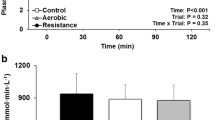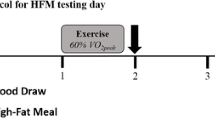Abstract
The transient impairment of endothelial function following a high-fat meal is well established. Brachial artery flow-mediated dilation (FMD) decreases between 2 and 6 h post ingestion. Whether this impairment can be reduced with acute aerobic exercise has not been investigated. The purpose of this study was to investigate if a single sustained aerobic exercise session can counteract the postprandial attenuation in brachial artery FMD associated with the ingestion of a high-fat meal. Eight apparently healthy adults (five men, three women), age 25.5 ± 0.8 years, performed three treatment conditions in a counter-balanced design: (1) low-fat meal alone (LFM), (2) high-fat meal alone (HFM), and (3) one session of aerobic exercise presented 2 h after ingesting a high-fat meal (HFM-EX). The examination of brachial artery FMD was performed at baseline and 4 h following the ingestion of the meal for each treatment condition. A 3 × 2 (treatment × time) repeated measures ANOVA exhibited a significant interaction (P = 0.019). Preprandial FMDs were similar (P = 0.863) among all three treatment conditions. The FMDs following the LFM (7.18 ± 1.31%) and HFM-EX (8.72 ± 0.94%) were significantly higher (P = 0.001) than the FMD following the HFM (4.29 ± 1.64%). FMD was significantly elevated above preprandial values following the HFM-EX (5.61 ± 1.54 to 8.72 ± 0.94%, P = 0.005) but was unchanged following the LFM (6.17 ± 0.94 to 7.18 ± 1.31%, P = 0.317) and the HFM (5.73 ± 1.23 to 4.29 ± 1.64%, P = 0.160). These findings suggest that a single aerobic exercise session cannot only counteract the postprandial endothelial dysfunction induced by the ingestion of a high-fat meal, but also increase brachial artery FMD in apparently healthy adults.

Similar content being viewed by others
References
American College of Sports Medicine (2005) ACSM’s guidlines for exercise testing and prescription, 7th edn. Lippincott Williams & Wilkins, Philadelphia
Anderson RA, Jones CJH, Goodfellow J (2001) Is the fat meal a trigger for acute coronary syndromes? Atherosclerosis 159:9–15
Bae JH, Bassinge E, Kim KB, Kim YN, Kim KS, Lee HJ, Moon KC, Lee MS, Park KY, Schewemmer M (2001) Postprandial hypertriglyceridemia impairs endothelial function by enhanced oxidant stress. Atherosclerosis 155:517–523
Borg GA (1973) Perceived exertion: a note on “history” and methods. Med Sci Sports 5:90–93
Celermajer DS, Sorensen KE, Gooch VM (1992) Non-invasive detection of endothelial dysfunction in children and adults at risk of atherosclerosis. Lancet 340:1111–1115
Corretti MC, Anderson TJ, Benjamin EJ, Celermajer D, Charbonneau F, Creager MA, Deanfield J, Drexler H, Gehard-Herman M, Herrington D, Vallance P, Vita J, Vogel R (2002) Guidelines for the ultrasound assessment of endothelial-dependent flow-mediated vasodilation of the brachial artery. J Am Coll Cardiol 39:257–265
Cuevas AM, Guasch V, Castillo O, Irribarra V, Mizon C, San Martin A, Strobel P, Perez D, Germain AM, Leighton F (2000) A high-fat diet induces and red wine counteracts endothelial dysfunction in human volunteers. Lipids 35:143–148
Devaraj S, Jialal I (1996) Oxidized low-density lipoprotein and atherosclerosis. Int J Clin Lab Res 26:178–184
Gaenzer H, Sturm W, Neumayr G, kirchmair R, Ebenbichler C, Ritsch A, Foger B, Weiss G, Patsch JR (2001) Pronounced postprandial lipemia impairs endothelium-dependent dilation of the brachial artery in men. Cardiovasc Res 52:509–516
Gill JMR, Al-Mamari A, Ferrell WR, Cleland SL, Packard CJ, Sattar N, Petrie JR, Caslake MJ (2004) Effects of prior moderate exercise on postprandial metabolism and vascular function in lean and centrally obese men. J Am Coll Cardiol 44:2375–2382
Harris RA, Padilla J, Rink LD, Wallace JP (2006) Variability of flow-mediated dilation measurements with repetitive reactive hyperemia. Vasc Med 11:1–6
Harvey PJ, Beverley LM, Kubo T, Picton PE, Su WS, Catherine FN, Floras JS (2005) Hemodynamic after-effects of acute dynamic exercise in sedentary normotensive postmenopausal women. J Hypertens 23:285–292
Ji LL (2002) Exercise-induced modulation of antioxidant defense. Ann N Y Acad Sci 959:82–92
Jungersten L, Ambring A, Wall B, Wennmalm A (1997) Both physical fitness and acute exercise regulate nitric oxide formation in healthy humans. J Appl Physiol 82:760–764
Katsanos CS, Moffatt RJ (2004) Acute effects of premeal versus postmeal exercise on postprandial hypertriglyceridemia. Clin J Sport Med 14:33–39
Meilhac O, Ramachandran S, Chiang K, Santanam N, Parthasarathy S (2001) Role of arterial wall antioxidant defense in beneficial effects of exercise on atherosclerosis in mice. Artherioscler Thromb Vasc Biol 21:1681–1688
Padilla J, Harris RA, Fly DA, Rink LD, Wallace JP (2006) A comparison between active- and reactive-hyperaemia-induced brachial artery vasodilation. Clin Sci 110:387–392
Plotnick GD, Corretti MC, Vogel RA (1997) Effect of antioxidant vitamins on the transient impairment of endothelium-dependent brachial artery vasoactivity following a single high-fat meal. JAMA 278:1682–1686
Ross R (1999) Atherosclerosis—an inflammatory disease. N Engl J Med 340:115–128
Sies H, Stahl W, Sevanian A (2005) Nutritional, dietary and postprandial oxidative stress. J Nutr 135:969–972
Steensberg A, Hall GV, Osada T, Sacchetti M, Saltin B, Pedersen BK (2000) Production of interleukin-6 in contracting human skeletal muscles can account for the exercise-induced increase in plasma interleukin-6. J Physiol 537:237–242
Tsai W, Li Y, LIn C, Chao T, Chen J (2004) Effects of oxidative stress on endothelial function after a high-fat meal. Clin Sci 106:315–319
Verma S, Buchanan MR, Anderson TJ (2003) Endothelial function testing as a biomarker of vascular disease. Circulation 108:2054–2059
Vogel RA, Corretti MC, Plotnick GD (1997) Effect of a single high-fat meal on endothelial function in healthy subjects. Am J Cardiol 79:350–354
Vollaard NBJ, Shearman JP, Cooper CE (2005) Exercise-induced oxidative stress. Myths, realities and physiological relevance. Sports Med 35:1045–1062
Walther C, Gielen S, Hambrecht R (2004) The effect of exercise training on endothelial function in cardiovascular disease in humans. Exerc Sport Sci Rev 32:129–134
Zhao T, Bokoch GM (2005) Critical role of proline-rish tyrosine kinase 2 in reversion of the adhesion mediated suppression of reactive oxygen species generaion by human neurophils. J Immun 174:8049–8055
Acknowledgment
This research was supported by the Clinical Exercise Physiology Laboratory and Nutrition Sciences Laboratory at Indiana University. J. Padilla is sponsored by a fellowship from the Ministerio de Educación y Cultura de España.
Author information
Authors and Affiliations
Corresponding author
Rights and permissions
About this article
Cite this article
Padilla, J., Harris, R.A., Fly, A.D. et al. The effect of acute exercise on endothelial function following a high-fat meal. Eur J Appl Physiol 98, 256–262 (2006). https://doi.org/10.1007/s00421-006-0272-z
Accepted:
Published:
Issue Date:
DOI: https://doi.org/10.1007/s00421-006-0272-z




